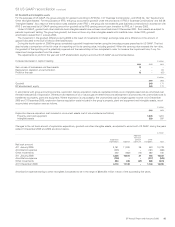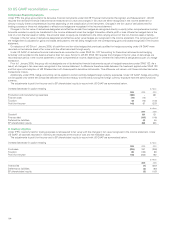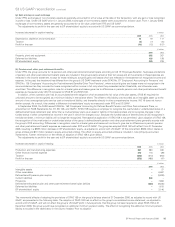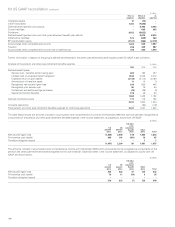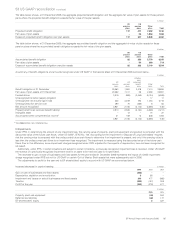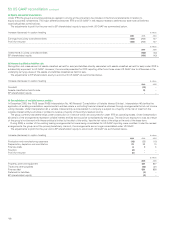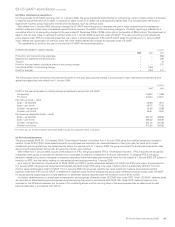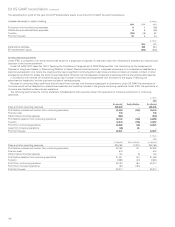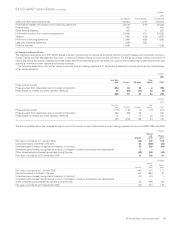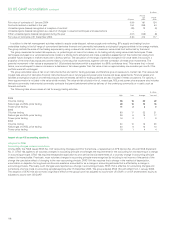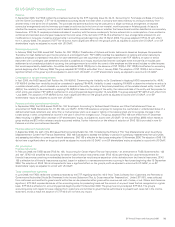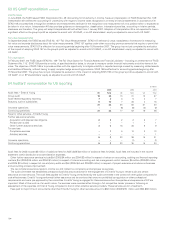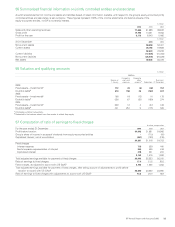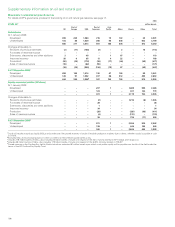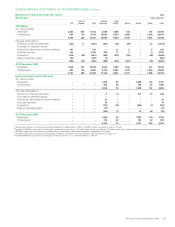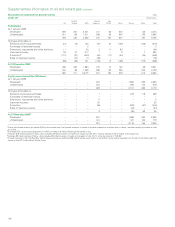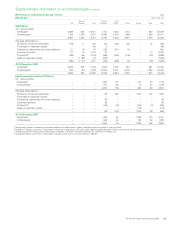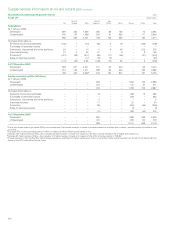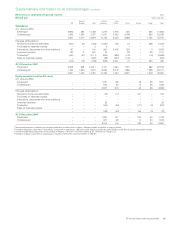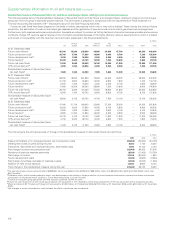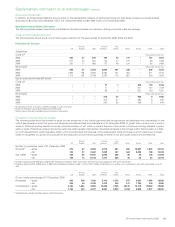BP 2006 Annual Report Download - page 195
Download and view the complete annual report
Please find page 195 of the 2006 BP annual report below. You can navigate through the pages in the report by either clicking on the pages listed below, or by using the keyword search tool below to find specific information within the annual report.BP Annual Report and Accounts 2006 193
53 US GAAP reconciliation continued
Revenue
In September 2005, the FASB ratified the consensus reached by the EITF regarding Issue No. 04-13 ‘Accounting for Purchases and Sales of Inventory
with the Same Counterparty’. EITF 04-13 addresses accounting issues that arise when a company both sells inventory to and buys inventory from
another entity in the same line of business. The purchase and sale transactions may be pursuant to a single contractual arrangement or separate
contractual arrangements and the inventory purchased or sold may be in the form of raw material, work-in-process or finished goods. At issue is
whether the revenue, inventory cost and cost of sales should be recorded at fair value or whether the transactions should be classified as non-monetary
transactions. EITF 04-13 requires purchases and sales of inventory with the same counterparty that are entered into in contemplation of one another be
combined and recorded as exchanges measured at the book value of the item sold. EITF 04-13 is effective for new arrangements entered into and
modifications or renewals of existing arrangements in accounting periods beginning after 15 March 2006. The group adopted EITF 04-13 with effect
from 1 January 2006. The adoption of EITF 04-13 did not have a significant effect on the group’s profit as adjusted to accord with US GAAP, or on BP
shareholders’ equity as adjusted to accord with US GAAP.
Share-based payments
In February 2006, the FASB issued Staff Position No. FAS 123(R)-4 ‘Classification of Options and Similar Instruments Issued as Employee Compensation
That Allow for Cash Settlement upon the Occurrence of a Contingent Event’. FSP 123(R)-4 clarifies the classification of options and similar instruments
issued as employee compensation that allow for cash settlement upon the occurrence of a contingent event. Under FSP 123(R)-4, an option or similar
instrument with a contingent cash settlement provision is classified as an equity award provided that the contingent event that permits or requires cash
settlement is not considered probable of occurring, the contingent event is not within the control of the employee and the award includes no other features
that would require liability classification. For entities that adopted SFAS 123(R) prior to the issuance of FSP 123(R)-4, FSP 123(R)-4 is effective for accounting
periods beginning after 3 February 2006. The group adopted FSP 123(R)-4 with effect from 1 January 2006. The adoption of FSP 123(R)-4 did not have a
significant effect on the group’s profit as adjusted to accord with US GAAP, or on BP shareholders’ equity as adjusted to accord with US GAAP.
Consolidation of variable interest entities
In April 2006, the FASB issued Staff Position No. FIN 46(R)-6, ‘Determining the Variability to Be Considered in Applying FASB Interpretation No. 46(R)’.
FSP 46(R)-6 clarifies how variability should be considered in applying FIN 46(R). Variability is used in applying FIN 46(R) to determine whether an entity is
a variable interest entity, which interests are variable interests in the entity, and who is the primary beneficiary of the variable interest entity. Under FSP
46(R)-6, the variability to be considered in applying FIN 46(R)-6 is based on the design of the entity, the nature and risks of the entity and the purpose for
which entity was created. FSP 46(R)-6 is effective for accounting periods beginning after 15 June 2006. The group adopted FSP 46(R)-6 with effect from
1 July 2006. The adoption of FSP 46(R)-6 did not have a significant effect on the group’s profit as adjusted to accord with US GAAP, or on BP
shareholders’ equity as adjusted to accord with US GAAP.
Pensions and other post-retirement benefits
In September 2006, the FASB issued SFAS No. 158 ‘Employers’ Accounting for Defined Benefit Pension and Other Post-retirement Plans, an
amendment of FASB Statements No. 87, 88, 106, and 132(R)’. SFAS 158 requires an employer to recognize the overfunded or underfunded status of a
defined benefit post-retirement plan (other than a multi-employer plan) as an asset or liability in the balance sheet and to recognize changes in that
funded status in other comprehensive income in the year in which the changes occur. The group adopted SFAS 158 with effect from 31 December
2006, resulting in a $599 million decrease in BP shareholders’ equity, as adjusted to accord with US GAAP. Of this total effect, $586 million relates to
group entities and $13 million relates to equity-accounted entities. Further information on the effects of adoption of SFAS 158 is provided in note (h)
Pensions and other post-retirement benefits.
Financial statement misstatements
In September 2006, the staff of the SEC issued Staff Accounting Bulletin No. 108, ‘Considering the Effects of Prior Year Misstatements when Quantifying
Misstatements in Current Year Financial Statements’. SAB 108 was issued to address the diversity in practice in quantifying misstatements from prioryears
and assessing their effect on current year financial statements. SAB 108 is effective for fiscal years ending after 15 November 2006. The adoption of SAB 108
did not have a significant effect on the group’s profit as adjusted to accord with US GAAP, or on BP shareholders’ equity as adjusted to accord with US GAAP.
Not yet adopted
Financial instruments
In February 2006, the FASB issued SFAS No. 155, ‘Accounting for Certain Hybrid Financial Instruments – an amendment of FASB Statements No. 133
and 140’. SFAS 155 simplifies the accounting for certain hybrid financial instruments under SFAS 133 by permitting fair value remeasurement for
financial instruments containing an embedded derivative that otherwise would require separation of the derivative from the financial instrument. SFAS
155 is effective for all financial instruments acquired, issued or subject to a remeasurement event occurring in fiscal years beginning after 15 September
2006. The adoption of SFAS 155 is not expected to have a significant effect on the group’s profit as adjusted to accord with US GAAP, or on BP
shareholders’ equity as adjusted to accord with US GAAP.
Taxes collected from customers
In June 2006, the FASB ratified the consensus reached by the EITF regarding Issue No. 06-3 ‘How Taxes Collected from Customers and Remitted to
Governmental Authorities Should Be Presented in the Income Statement (That Is, Gross versus Net Presentation)’. Under EITF 06-3, taxes collected
from customers and remitted to governmental authorities can be presented either gross within revenue and cost of sales, or net. Where such taxes are
significant, EITF 06-3 requires disclosure of the accounting policy for presenting taxes and the amount of any such taxes that are recognized on a gross
basis. EITF 06-3 is effective for accounting periods beginning after 15 December 2006. The group has not yet adopted EITF 06-3. The group’s
accounting policy with regard to taxes collected from customers and remitted to governmental authorities is to present such taxes net in the income
statement, and as a result the adoption of EITF 06-3 will not have any impact.


